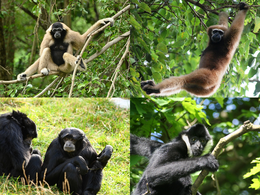
Back Gibbon Afrikaans ጊቦን Amharic جبون Arabic جيبون (فصيله) ARZ Hylobatidae AST Hibbonlar Azerbaijani Гібонавыя BE-X-OLD Гибони Bulgarian Uwa-uwa BJN Gibon Breton
| Gibbons[1][2] Temporal range: Late Miocene–recent
| |
|---|---|

| |
| Gibbon species of different genera; from top-left, clockwise: Pileated gibbon (Hylobates pileatus), western hoolock gibbon (Hoolock hoolock), yellow-cheeked gibbon (Nomascus gabriellae), siamang (Symphalangus syndactylus) | |
| Scientific classification | |
| Domain: | Eukaryota |
| Kingdom: | Animalia |
| Phylum: | Chordata |
| Class: | Mammalia |
| Order: | Primates |
| Suborder: | Haplorhini |
| Infraorder: | Simiiformes |
| Parvorder: | Catarrhini |
| Superfamily: | Hominoidea |
| Family: | Hylobatidae Gray, 1870 |
| Type genus | |
| Hylobates Illiger, 1811
| |
| Genera | |

| |
| Distribution in Southeast Asia | |
Gibbons (/ˈɡɪbənz/) are apes in the family Hylobatidae (/ˌhaɪləˈbætɪdiː/). The family historically contained one genus, but now is split into four extant genera and 20 species. Gibbons live in subtropical and tropical rainforests from eastern Bangladesh to Northeast India to southern China and Indonesia (including the islands of Sumatra, Borneo and Java).
Also called the lesser apes, gibbons differ from the great apes (chimpanzees, gorillas, orangutans and humans) in being smaller, exhibiting low sexual dimorphism, and not making nests.[5] Like all of the apes, gibbons are tailless. Unlike most of the great apes, gibbons frequently form long-term pair bonds. Their primary mode of locomotion, brachiation, involves swinging from branch to branch for distances up to 15 m (50 ft), at speeds as fast as 55 km/h (34 mph). They can also make leaps up to 8 m (26 ft), and walk bipedally with their arms raised for balance. They are the fastest of all tree-dwelling, nonflying mammals.[6]
Depending on the species and sex, gibbons' fur coloration varies from dark- to light-brown shades, and any shade between black and white, though a completely "white" gibbon is rare.
- ^ Groves, C. P. (2005). Wilson, D. E.; Reeder, D. M. (eds.). Mammal Species of the World: A Taxonomic and Geographic Reference (3rd ed.). Baltimore: Johns Hopkins University Press. pp. 178–181. ISBN 0-801-88221-4. OCLC 62265494.
- ^ Mootnick, A.; Groves, C. P. (2005). "A new generic name for the hoolock gibbon (Hylobatidae)". International Journal of Primatology. 26 (4): 971–976. doi:10.1007/s10764-005-5332-4. S2CID 8394136.
- ^ Ji, Xueping; Harrison, Terry; Zhang, Yingqi; Wu, Yun; Zhang, Chunxia; Hu, Jinming; Wu, Dongdong; Hou, Yemao; Li, Song; Wang, Guofu; Wang, Zhenzhen (2022-10-01). "The earliest hylobatid from the Late Miocene of China". Journal of Human Evolution. 171: 103251. doi:10.1016/j.jhevol.2022.103251. ISSN 0047-2484. PMID 36113226. S2CID 252243877.
- ^ "Appendices | CITES". cites.org. Retrieved 2022-01-14.
- ^ "Gibbon Conservation Center Working to Save South Asia's Hoolock Gibbons & Other "Small Apes"". National Geographic =. Archived from the original on November 5, 2014. Retrieved 14 February 2016.
- ^ "Gibbon". a-z animals. Retrieved 26 March 2015.
© MMXXIII Rich X Search. We shall prevail. All rights reserved. Rich X Search